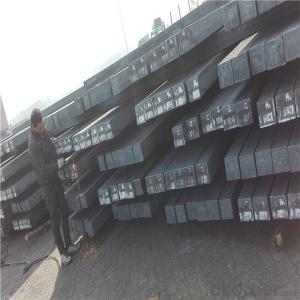Steel Billet made in China with High quality
- Loading Port:
- Tianjin
- Payment Terms:
- TT OR LC
- Min Order Qty:
- 1000 m.t.
- Supply Capability:
- 17642 m.t./month
OKorder Service Pledge
OKorder Financial Service
You Might Also Like
Item specifice
Steel billet :
Steel billet(ingot) by cogging or breakdown of semi-finished products, is the raw material of all kinds of steel mill. Billet section of square, round, flat, rectangular
and abnormity of several kinds of, mainly related to the shape of rolled products.
Billets, or ingots (as they sometimes referred to), are not of practical use until they have been formed into more
functional shapes and sizes. While they have already been put in the furnace, they still require a series of shaping
and molding procedures such as hot and cold working, milling and cutting before they are sold in hardware stores,
or used for different applications. The unformed billets, however, can be used in striking currency such as coins and
as reserves, similar to gold bars.
Gade:
Standard | C(%) | Mn(%) | S(%) | P(%) | Si(%) |
Q195 | ≤0.12 | ≤0.50 | ≤0.040 | ≤0.035 | ≤0.30 |
Q235 | ≤0.20 | ≤1.40 | ≤0.045 | ≤0.045 | ≤0.35 |
Q275 | ≤0.22 | ≤1.50 | ≤0.045 | ≤0.045 | ≤0.35 |
20MnSi | 0.17-0.25 | 1.2-1.6 | ≤ 0.050 | ≤ 0.050 | 0.40-0.80 |
3SP | 0.14-0.22 | 0.40-0.85 | ≤ 0.050 | ≤ 0.040 | 0.05-0.15 |
5SP | 0.28-0.37 | 0.50-1.00 | ≤ 0.050 | ≤ 0.040 | 0.15-0.30 |
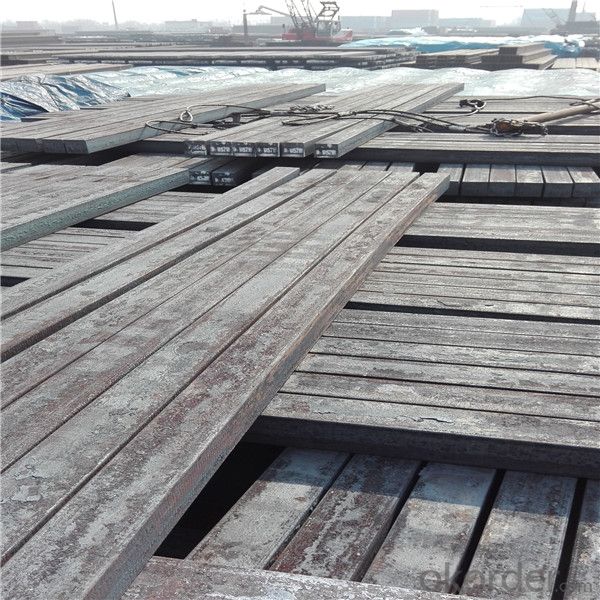
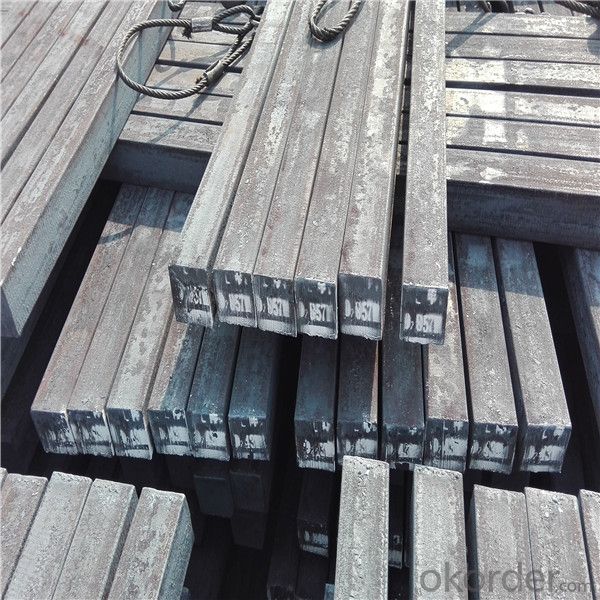
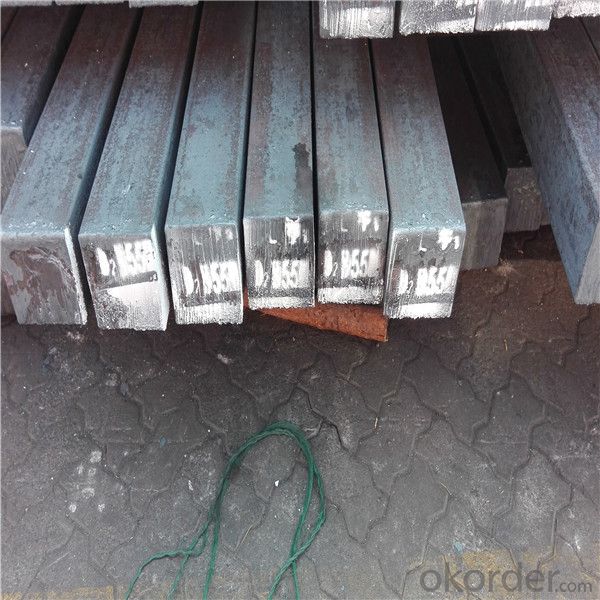
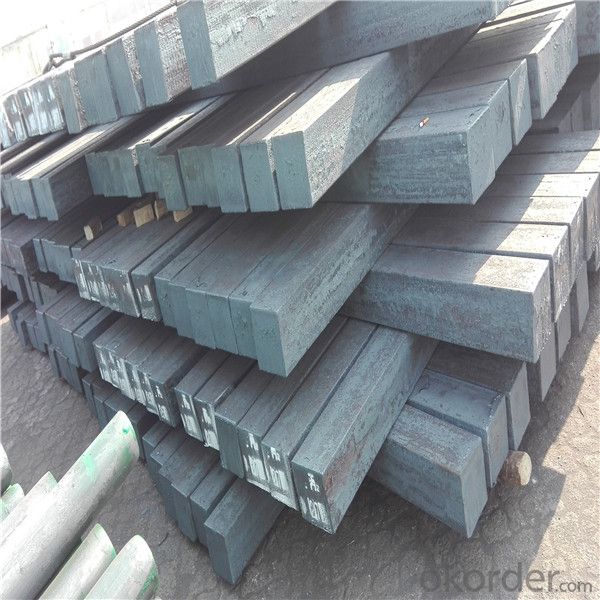
Other Specifications
Squar Tolerance: ±4
Length Tolerance: +100mm
Romboidity/Difference Diagonals: no more than 0.7%
Camber: no more than 1.5%(%)
Twist: no more than 3 degrees per 1 meter length
Our Advantage
* Professional Personnel of Steel Trading
* Strong Steel Industry Background
* Conveniently Geographic Location
Our Commitment
* Sincere, Practical, Efficient and Developing
* High Quality Steel Production
* Competitive Price and Timely Delivery
Packing :
Within 30 days
1.Standard export package
2.In bundles with steel strips
3.As the requirements of the customers
FAQ:
Q: How to get quotation?
A: When we receive your detailed enquiry, we will set the best price based on standard,
steel grade, outer diameter, wall thickness, quantity, country.
And we will send quotation to your mailbox.
Q:How to guarantee the quality of the products?
A:We have established the international advanced quality management system,every link from raw material
to final product we have strict quality test;We resolutely put an end to unqualified products flowing into the market.
At the same time, we will provide necessary follow-up service assurance.
Q:How long can we receive the product after purchase?
A :In the purchase of product within three working days, We will arrange the factory delivery as soon as possible.
The pecific time of receiving is related to the state and position of customers.
- Q:What is the role of steel billets in the production of valves and fittings?
- Valves and fittings, which are crucial in industries like oil and gas, petrochemical, and water treatment, rely heavily on steel billets. These billets, derived from molten steel, serve as the starting point for producing these components. To meet specific requirements, the billets are cast into shapes like round, square, or rectangular. The usage of steel billets enables manufacturers to maintain consistent quality and performance in valves and fittings. The selection process involves considering factors such as chemical composition, mechanical properties, and microstructure to guarantee the desired characteristics in the end product. After obtaining the steel billets, they undergo various manufacturing processes like forging, machining, and heat treatment. These processes further enhance the strength, integrity, and functionality of the final valve and fitting components. One of the advantages of steel billets is their versatility in customization. They can be easily cut, shaped, and formed to create valves and fittings with different sizes, configurations, and designs. This flexibility allows them to meet the specific requirements of different applications and industries. In summary, steel billets serve as the raw material for valves and fittings, playing a vital role in their production. Their strength, durability, and customization capabilities ensure the reliability and performance of these components in various industrial settings.
- Q:What are the different types of cutting processes used for shaping steel billets?
- Steel billets can be shaped using various cutting processes. Some of these methods include: 1. Bandsaw cutting, a popular technique that employs a continuous band of toothed metal blade to cut through the billet. Bandsaws are highly regarded for their quick and accurate cutting of thick steel sections. 2. Abrasive cutting, which involves using an abrasive wheel or disc to slice through the billet. This method is versatile, being suitable for smaller billets and for creating intricate shapes and contours. It is known for its ability to produce precise and smooth cuts. 3. Plasma cutting, a thermal cutting process that employs a high-velocity jet of ionized gas to melt and eliminate the steel from the billet. This technique is often employed for thick steel sections and intricate shapes. It boasts high speed and the ability to produce clean cuts. 4. Waterjet cutting, a process that employs a high-pressure jet of water to cut through the steel billet. In some cases, abrasive particles may be introduced to enhance the cutting ability. Waterjet cutting is renowned for its capability to cut through thick steel sections without causing heat-affected zones or distortion. 5. Laser cutting, which utilizes a high-powered laser beam guided by computer controls to melt and vaporize the steel billet. This method is known for its precision and the ability to cut intricate shapes with minimal distortion. These examples represent only a few of the cutting processes available for shaping steel billets. Each technique has its own set of advantages and is selected based on factors such as billet size, desired shape, and required accuracy.
- Q:What are the different types of steel billet cutting tools?
- There are several different types of steel billet cutting tools available, each designed for specific purposes and applications. Some of the most common types include: 1. Bandsaw: This type of cutting tool uses a continuous loop of toothed blade to cut through steel billets. Bandsaws are versatile and can be used for both straight and curved cuts. 2. Circular saw: Circular saws feature a toothed blade that rotates in a circular motion to cut through steel billets. They are known for their speed and efficiency, making them a popular choice for large-scale cutting operations. 3. Abrasive cut-off saw: These tools use a high-speed rotating abrasive disc to cut through steel billets. Abrasive cut-off saws are ideal for cutting through thick and hard materials quickly. 4. Plasma cutter: Plasma cutters use a high-velocity jet of ionized gas to melt and cut through steel billets. They are known for their precision and ability to cut through thick materials with ease. 5. Waterjet cutter: Waterjet cutters use a high-pressure jet of water mixed with abrasive particles to cut through steel billets. This type of cutting tool is highly accurate and does not generate heat, making it suitable for cutting heat-sensitive materials. 6. Laser cutter: Laser cutters use a high-powered laser beam to melt and vaporize steel, creating a precise and clean cut. Laser cutting is known for its high level of accuracy and versatility. These are just a few examples of the different types of steel billet cutting tools available. The choice of tool depends on factors such as the type and thickness of the material being cut, the desired level of precision, and the specific application requirements.
- Q:How are steel billets used in the production of aerospace parts?
- Steel billets are used in the production of aerospace parts as they serve as the starting material for forging or machining processes. These billets are heated, shaped, and then further processed to create the desired components, such as engine parts, landing gear components, or structural elements, which are crucial for the performance and safety of aerospace machinery.
- Q:How do steel billets contribute to the manufacturing of tools and equipment?
- Steel billets are an essential raw material in the manufacturing of tools and equipment. These hot-rolled or forged semi-finished steel products serve as the starting point for various manufacturing processes. They are shaped, machined, and heat-treated to create specific components or parts used in tools and equipment. The high strength, durability, and versatility of steel billets make them ideal for producing a wide range of tools and equipment, including cutting tools, molds, dies, gears, and machine components.
- Q:How are steel billets used in the production of automotive steering systems?
- Steel billets are used in the production of automotive steering systems as they serve as the raw material for forging steering components such as the steering arm, tie rod ends, and steering knuckles. These billets are heated and shaped through forging processes to create strong and durable steering components that ensure the reliable performance and safety of the steering system in vehicles.
- Q:How do steel billets contribute to the overall vibration resistance of a product?
- Steel billets contribute to the overall vibration resistance of a product by providing a strong and rigid foundation. The high strength and stiffness of steel billets help to absorb and dissipate vibrations, preventing excessive movement and reducing the risk of structural damage. Moreover, their dense and homogeneous composition minimizes resonance effects, further enhancing the product's vibration resistance.
- Q:How do steel billets come out?
- I. mining1, iron ore2 limestone mine3, coal mineTwo 、 burden preparation1. Iron ore sintering2 coking coal cokingThree, iron: in the blast furnace, sintering iron ore, limestone, coke, iron ore in the iron elements reduced to metal iron, then the product is pig iron.
- Q:Can steel billets be used for making architectural structures?
- Yes, steel billets can be used for making architectural structures. Steel billets are semi-finished products that are typically cast into specific shapes and sizes before being further processed into different steel products. These billets can be used as a raw material for fabricating various architectural structures such as beams, columns, frames, and trusses. Steel is a widely used material in the construction industry due to its high strength, durability, and versatility. It offers several advantages over other construction materials, including its ability to withstand heavy loads, resist corrosion, and provide excellent fire resistance. Steel billets can be processed and shaped into different forms, allowing architects and engineers to create innovative and complex architectural designs. Furthermore, steel structures offer several benefits in terms of cost-effectiveness, speed of construction, and sustainability. Steel is a highly recyclable material, making it an environmentally friendly choice. The use of steel billets in architectural structures enables the construction of large and complex structures with greater precision and efficiency. Overall, steel billets can be effectively used in the construction of architectural structures, offering numerous advantages in terms of strength, durability, design flexibility, and sustainability.
- Q:What are the key properties and characteristics of steel billets?
- Steel billets, which have a rectangular shape and typically a square cross-section, are semi-finished steel products. They serve as the initial stage for manufacturing various steel products such as bars, rods, and wire. Steel billets possess several important properties and characteristics: 1. Composition: Steel billets primarily consist of iron and carbon, with additional alloying elements incorporated to enhance specific properties. The carbon content generally ranges from 0.2% to 0.5%, depending on the desired strength and hardness. 2. Strength and Hardness: Due to their composition and heat treatment processes, steel billets offer excellent strength and hardness. This makes them suitable for applications requiring high load-bearing capacity and resistance to wear and tear. 3. Ductility: Despite their strength, steel billets also exhibit good ductility, allowing them to be easily shaped and formed into various products through processes like rolling, extrusion, and forging. This versatility enables their use in different manufacturing methods. 4. Homogeneity: Steel billets possess a uniform internal structure, ensuring consistent mechanical properties throughout the entire material. This homogeneity is achieved through precise casting and cooling processes, which minimize the presence of defects and impurities. 5. Dimensional Precision: Steel billets are manufactured with specific dimensions and tolerances, ensuring the desired size and shape for downstream processing. This dimensional precision enables efficient and accurate production, minimizing waste and maximizing productivity. 6. Surface Quality: Steel billets have a smooth and clean surface finish, free from significant imperfections or irregularities. This is crucial for subsequent processing steps, as it ensures proper bonding during welding, machining, or coating operations. 7. Heat Conductivity: Steel billets exhibit excellent thermal conductivity, efficiently transferring heat during various manufacturing processes like hot rolling or continuous casting. This property ensures uniform heating and cooling, resulting in consistent material properties. 8. Corrosion Resistance: Steel billets are prone to corrosion if left unprotected. However, they can be coated or treated with anti-corrosive measures to enhance their resistance to rust and other forms of degradation. In summary, steel billets are characterized by their strength, ductility, dimensional precision, and homogeneity. These properties make them a critical raw material in the steel industry, facilitating the production of high-quality steel products used in diverse sectors such as construction, automotive, and infrastructure.
1. Manufacturer Overview |
|
|---|---|
| Location | |
| Year Established | |
| Annual Output Value | |
| Main Markets | |
| Company Certifications | |
2. Manufacturer Certificates |
|
|---|---|
| a) Certification Name | |
| Range | |
| Reference | |
| Validity Period | |
3. Manufacturer Capability |
|
|---|---|
| a)Trade Capacity | |
| Nearest Port | |
| Export Percentage | |
| No.of Employees in Trade Department | |
| Language Spoken: | |
| b)Factory Information | |
| Factory Size: | |
| No. of Production Lines | |
| Contract Manufacturing | |
| Product Price Range | |
Send your message to us
Steel Billet made in China with High quality
- Loading Port:
- Tianjin
- Payment Terms:
- TT OR LC
- Min Order Qty:
- 1000 m.t.
- Supply Capability:
- 17642 m.t./month
OKorder Service Pledge
OKorder Financial Service
Similar products
New products
Hot products
Related keywords
